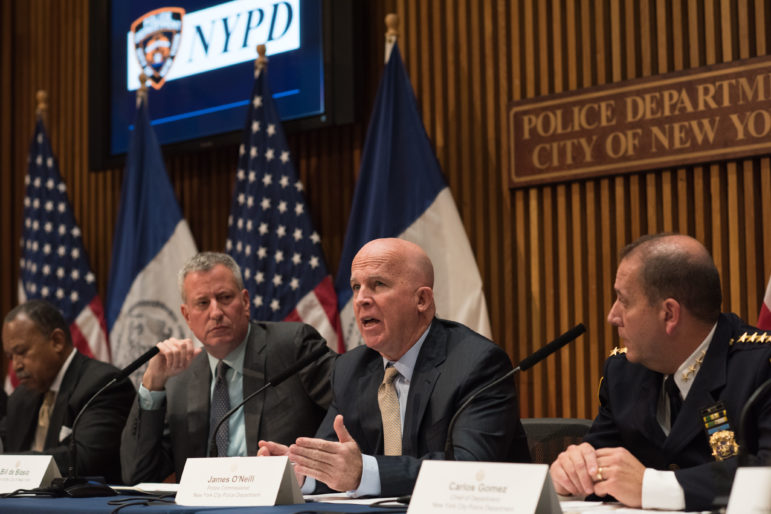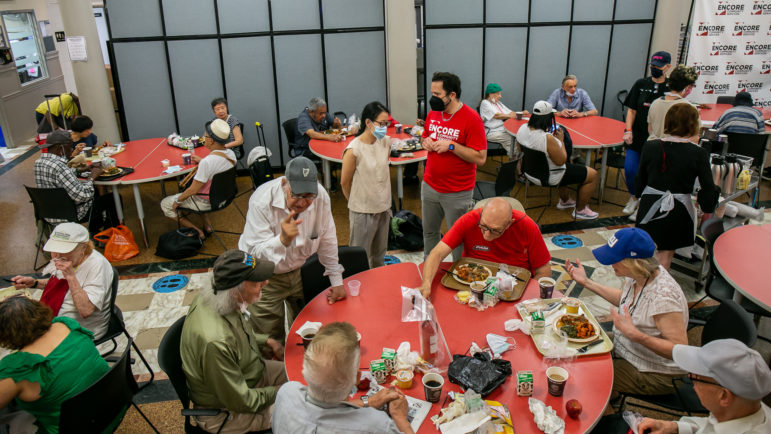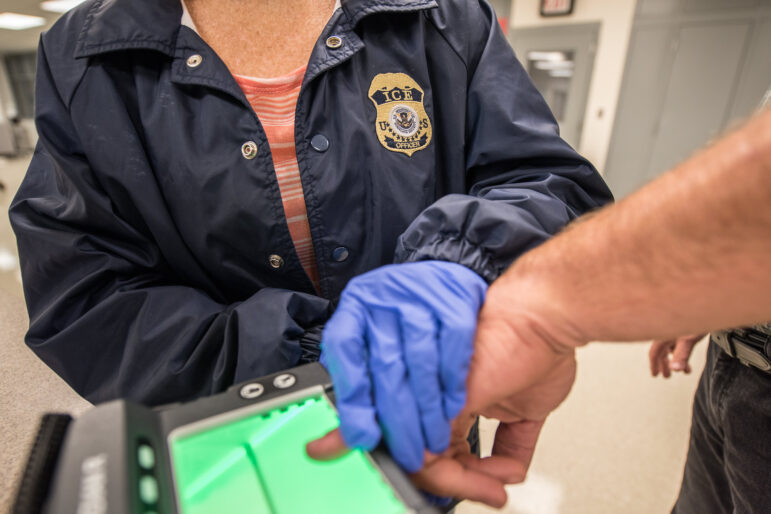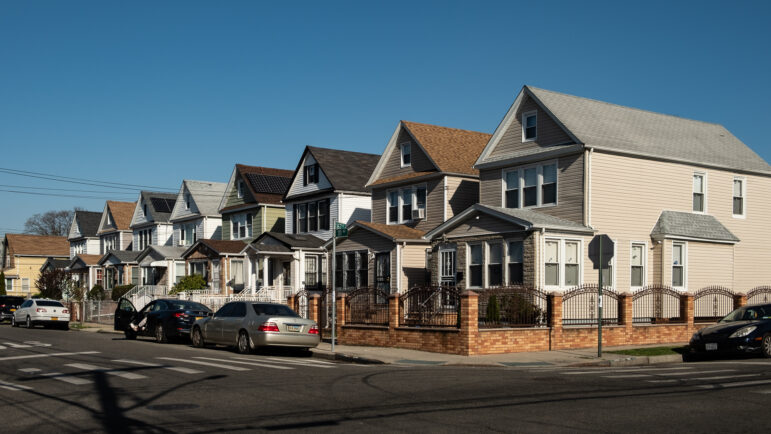
Michael Appleton/Mayoral Photography Office
Mayor Bill de Blasio and Police Commissioner James O'Neill hold a press conference at One Police Plaza in Manhattan to discuss the latest crime statistics on Monday.
Stop and frisk in the city isn’t over. But you might not know it if you watched national headlines last week.
The binary talking points over New York’s use of stop and frisk after Donald Trump’s comments last Monday night at the presidential debate have mostly fallen into two predictable partisan positions: For Trump and his ilk, stop and frisk worked magic in New York and we should have never let up on it. As proof, Trump suggested that the city had gone to hell in a handbasket. On the liberal side of the coin the thinking is that stop and frisk was ineffective (true enough) and that the city is a shining example of how we end the practice and still be safe.
That could be true if we had actually ended it. We haven’t. What do the numbers show? Well that depends on whether or not you believe them.
Data for 2014 and 2015 suggest that the controversial policing tactic continues in the tens of thousands. For both the Trump camp and most supporters his Democratic rival, Hillary Clinton, staking out a position for or against stop and frisk glosses over that there are still tens of thousands of recorded stops and that the numbers suggest Blacks and Latinos are still being profiled. The NYPD reported over 45,000 stops in 2014 and 22,000 last year. The Bill de Blasio administration, which is aligned with the Clinton camp, claims credit for what data suggests is an amazing decline from much higher numbers under his predecessor, Mike Bloomberg. However, it was under Bloomberg and ex-police commish Ray Kelly that the reported numbers actually began to fall from a peak of almost 700,000 in 2011 to just over 190,000 in their final year in office. More than two-thirds of (recorded) annual stop and frisks disappeared under their leadership.
Think about that: Bloomberg, not de Blasio, set us down the path to less stop and frisk (at least according to the data). What a nice guy. Perhaps that’s why Bloomberg was asked to speak at the Democratic National Conference earlier this year where he was applauded by ‘progressive’ city elected officials like council speaker Melissa Mark-Viverito and public advocate Tish James.

No Backspace is City Limits’ blog featuring a recurring cast of opinion writers passionate about New York people, policies and politics. The views expressed here aren’t necessarily those of City Limits. Click here to read more.
Or maybe the truth is a little more complicated. Is it possible that stops are being deliberately and artificially kept low by a department that is simply not recording every interaction? The NYPD self reports enforcement data. Given the fact that the NYPD has been known to manipulate crime data, as laid out in a 2012 John Jay College report that noted a culture of stat-fudging, it’s possible that the ballyhooed decline in stops has been a statistical fabrication. Court-appointed federal monitor Peter Zimroth noted last year that stops are being “undercounted” by the NYPD. If cops are daring enough to downgrade crimes for their own purposes, taking their self-reporting at face value may be naive. How can we be sure of what the police are actually doing if the police are the ones we rely on for the data? When crime data and enforcement data become highly politicized, you must take all police data with a grain of salt. It’s similarly possible, as Police Reform Organizing Project’s Bob Gangi has remarked, that the NYPD wasn’t even doing the high numbers of 2011.
Clinton, who is rumored to be wooing the just-departed Bill Bratton (the godfather of stop and frisk and Broken Windows policing) for her administration, echoes the narrative from city hall that the stop and frisk era is over. A closer look at the ongoing numbers of stop and frisk are revealing. The majority of people stopped during de Blasio’s first two years–around 80 percent–are completely innocent. Remembering that the supreme court’s Terry V. Ohio decision (the well from which institutionalized stop and frisking sprang) validated stop and frisk chiefly for instances when cops had reasonable suspicion of someone being “armed and presently dangerous”, it’s important to note that most of those 20 percent who were ‘guilty’ were guilty of small fry stuff, like having a bag weed in their pocket–not for having a gun. In other words, this policing strategy is still mind-bogglingly ineffective at getting guns off the street.
The de Blasio administration has taken great pride in their 20 percent effective version of stop and frisk, mostly because it’s not as bad as Bloomberg’s ratio. However, a look at the racial disparities, which are what angered most New Yorkers (and fueled the federal lawsuit) show an eye-popping 83 percent of those stopped under de Blasio last year were Black or Latino. So while overall crime is still low, disproving Trump’s fear-mongery assertions that New York has become New Jack City without mass stop and frisk, racial profiling would seem to continue even as the de Blasio administration spikes their political football over police reform.
So although neither the Trump view of New York (that the city is crime-ridden) nor the de Blasio-Clinton version (that stop and frisk is essentially over) is true, the deeper problem might be in how we’ve come to measure racialized policing. By framing the police puzzle primarily through numbers, then the huge fight over police abuse can come down to a few spreadsheets. Police reform then can hinge on a few filled or unfilled reports–which, again, we have to trust the NYPD to complete honestly and accurately. This focus on numbers is a path that liberal-leaning legal organizations like the New York Civil Liberties Union and the Center for Constitutional Rights have put us on but it’s not going to change the NYPD.
While data is not unimportant, it doesn’t get the heart of what’s wrong–it merely shows us symptoms. Lawyers, most of whom (I will confidently assume) have never been stopped, can miss the point. For some, the problems are simply ones of constitutionality or compliance or just better numbers. This is at best naive, at worst self-serving. Take for example the problem of racial proportions. The police could, in theory (they never would), begin to stop thousands and thousands more white people until the race proportions matched the population. But do we want a police state to simply be spread out more evenly? I certainly wouldn’t take any solace in being stopped randomly on the street if there were simply more whites being stopped too. The best way to end the abuses of stop and frisk, which is fundamentally flawed, would be to end stop and frisk altogether. You want to know the best numbers and ratios for the practice? Zero.
Ultimately, the problems with police are political problems. The fact that the NYPD can squeeze out 1,300 extra cops during record low crime, for example, showcases how powerful the department is as an institution. Before leaving office earlier this month, Bratton remarked that the de Blasio administration was the most generous he had ever worked for in his entire career. The department’s $5.5 Billion dollar budget is a testament to their power. These are the much more important police numbers. And, of course, there are other daily reminders of police power: cops who walk free after killing unarmed New Yorkers, police cars parked in bike lanes. Et cetera. Et cetera.








